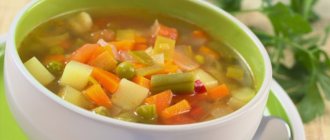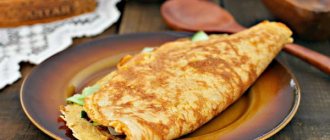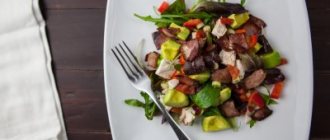Hello readers of my blog. Today I want to continue the topic of proper nutrition started in this article.
I have also already talked about the components of proper nutrition and the importance of balancing them.
Here, I want to talk about another fact that needs to be taken into account when compiling our daily menu - the compatibility of products for proper nutrition.
Eating compatible foods will help our body fully absorb the nutrients of a particular product.
How does this happen?
All food products have a different chemical composition, which of course affects their “digestibility” in our body: • this is the time that needs to be spent on digesting a certain group of products; • these are certain enzymes that process this food.
Let me explain this in a little more detail.
There are foods that are quickly digested, and there are foods that are slowly digested. If we consume them together, then food, which should quickly leave our body, will linger longer, the digestion process is disrupted - the food is not digested, but simply rots or ferments!
For example, an apple eaten at work (as a snack) leaves the stomach within half an hour. If we “snack” an apple after potatoes and meat (it takes more than 4 hours to digest), then it remains with these “slow” products and after 30 minutes it is already completely fermented.
In addition, a particular product in the stomach requires a different environment. So meat needs an acidic environment, and potatoes are “processed” into an alkaline environment.
The large intestine is also involved in all this. In it, food is no longer “processed” by our enzymes, but by our microorganisms - bacteria.
Let's roughly divide them into good and bad.
The good ones increase our immunity, help us “absorb” vitamins, process fiber, fight bad bacteria, etc.
Bad ones are all sorts of pathogenic microorganisms that are always present in our body. But some even help - they fight our “wrong” food, help quickly process it and remove it from the body.
So - raw plant food is processed by our well-wishers - beneficial bacteria, and the more and longer we consume such food, the more of them and the stronger our immunity becomes. And when we mix food - meat with salad, then a war begins in the intestines (and the consequences are gases) of who will win.
Therefore, it is very important for us to know how to properly combine foods with proper nutrition so that digestion time, enzymes, etc. more or less coincided, and there will be no imbalance in the process of their processing, because this is the basis of a healthy lifestyle .
Of course, we don’t know what we process with what, and what is combined with what.
But there was a doctor, Herbert Shelton, who offered us his table of food compatibility for proper nutrition.
There are controversial points in this table that modern scientists criticize (we know how they feel about everything that contradicts their dogmas). Of course, we cannot determine the correctness of all combinations of products, so whether to believe or not is up to you.
And further. You can always check with your body, and it will always tell you whether you have chosen the right combination or not.
How to Use a Food Combination Chart
The highlighted color means: Green cell – compatible products. Yellow - can be combined. Red – incompatible products.
For example, let’s look at how butter and bread combine. Butter - No. 3, bread - No. 7. We look at the intersection of No. 3 with No. 7 - we see green, ideal. That is, these are compatible products.
The essence of separate nutrition according to Shelton
Nowadays, hundreds of nutritionists around the world attribute this technique to themselves.
However, in reality, it was Herbert Shelton, an American naturopathic nutritionist, who created separate nutrition. In the 20s of the last century, Shelton’s first book, “The Right Combination of Foods,” was published. He identified several groups of them, studied their properties, and on the basis of this put forward a theory about the compatibility and incompatibility of different dishes and substances. The Shelton diet is based on this principle: something can be eaten together - and it brings health benefits, and beneficial substances are well absorbed in each other’s company, but something absolutely cannot be done for the opposite reasons - different dishes are required to digest these dishes groups of enzymes that cannot be secreted in our stomach at the same time. The main postulate of the American nutritionist says: the simpler our food, the greater the value and benefit it brings to our body. The doctor advised not to mix more than two or three products at the same time.
Explanation of some products from the table
No. 8. Tomatoes and sour fruits These are tomatoes and fruits that have acid - currants, strawberries, pineapples, pomegranates, strawberries, limes, tangerines, grapefruits and oranges.
No. 9. Semi-acidic fruits These include - quince, grapes, gooseberries and raspberries, blackberries, blueberries, cherries, gooseberries, nectarines and peaches, pears and apples, plums and apricots
No. 10. Sweet fruits These are figs, bananas, dried fruits, mangoes, persimmons, etc.
No. 11. Non-starchy vegetables Brussels cabbage, white cabbage and cauliflower, broccoli, parsnips, celery, sorrel, cucumbers, eggplant, lettuce, peppers (sweet), rutabaga. Sprouts: wheat, barley, alfalfa, etc.
No. 12. Starchy vegetables Artichoke, beans, carrots, corn, peanuts* Jerusalem artichoke, peas, potatoes, pumpkin. * Peanuts, lentils, legumes and all grains combine both protein and starch.
Principles of separate nutrition and product compatibility table
Separate nutrition has ancient roots, but it gained popularity only in the twentieth century at the instigation of Herbert Shelton. At the moment, doctors and nutritionists are divided into two opposing camps. Some prove the usefulness of this diet, others - its harm. However, it is an undeniable fact that people who stick to these basics have managed to lose weight over a short period of time. Before switching to such a diet, you should consult a specialist.
WEIGHT LOSS STORIES OF STARS!
Irina Pegova shocked everyone with her weight loss recipe: “I lost 27 kg and continue to lose weight, I just brew it at night. » Read more >>
Herbert Shelton developed a set of simple rules for a separate power supply system:
| Name | The essence of the rule |
| Mode | You should adhere to your diet - eat at least 3 times at your usual time |
| Thirst | You should not drink not only water, but also any other drinks during meals. It is healthier to take a glass of water 10–30 minutes before meals |
| Chewing Properly | Food is poorly digested on the go. Foods must be thoroughly chewed |
| Don't overeat | A single serving should not exceed 250–300 g |
| Simple food | Multi-component dishes will not meet the nutritional compatibility of separate meals |
| Sleeping mode | On average, for normal functioning of the body, you need to sleep 6-9 hours a day. |
| Compatibility | Do not combine incompatible products |
| Water balance | You should drink 1.5-2 liters of water per day |
Also, the principles of separate nutrition include cases when eating food will not benefit the body:
- Pain, mental and physical malaise are contraindications to eating food.
- Before, after, or during strenuous physical or mental activity, food may not be properly absorbed.
- A person should not eat food if he has not yet felt hungry.
To quickly assimilate a particular product, the stomach must produce the “correct” juice, saturated with the necessary enzymes for digestion. Protein foods are best digested in an acidic environment, carbohydrates in an alkaline environment. When proteins and carbohydrates are consumed simultaneously, a chemical reaction occurs in which the alkali and acid neutralize each other. This makes it difficult to absorb nutrients.
Digestion of a variety of foods requires an individual set of enzymes in the gastric juice:
| Digestion medium | Product groups |
| Acidic | Meat, eggs, fish, seafood, legumes, citrus fruits, exotic fruits (except bananas), cheese, berries, natural juices, fruit teas, semi-dry wines, cider, stone and pome fruits |
| Alkaline | Bakery and flour products, cereals, starchy vegetables, bananas, dried fruits and berries (raisins, dried apricots, dates, figs), sweets and beer |
| Neutral | Leafy vegetables, asparagus, garlic, eggplant, cucumber, carrots, pumpkin, mushrooms, celery, avocado, jellies, spices, herbal teas, olives, fats, nuts |
Based on changes in the chemical composition of gastric juice depending on the food consumed, a food compatibility table was developed, for which Shelton proposed his own classification of food:
| Category | What does it apply to |
| Protein | All meat products (except fat), eggs, fish, yeast, cheese, olives, avocado, soy, most types of nuts and seeds |
| Coal-water-containing | Cereals, green peas, potatoes, chestnuts, sugar |
| Fats | All types of vegetable and animal fats, oil |
| Sour fruits and vegetables | Oranges, lemons, pineapples, grapefruits, pomegranates, plums, grapes, sour apples (seven), peaches, tomatoes, sauerkraut |
| Semi-acidic fruits | Sweet cherries, apples, plums, figs, blueberries, mangoes, pears, apricots |
| Non-starchy and green vegetables | Cabbage (almost all types except starchy ones), cucumbers, parsley, broccoli, garlic, spinach, turnips, lettuce, French endive, mustard, green corn, onions, shallots, leeks, asparagus, green peas, celery , dandelion, sorrel, eggplant, pumpkin, radish, sweet pepper, watercress, asparagus |
Modern product compatibility schemes classify them much more widely, which helps to more accurately create an individual menu:
Red color - incompatible, yellow - acceptable combination, green - well compatible
When the principles of separate nutrition have already been studied, you can create an individual menu. First you need to decide on a healthy diet for a few days or a week. Possible menu options are presented in the table (in addition to the indicated products, vegetable salad should be consumed for all lunches and dinners):
| Days of the week | Breakfast | Dinner | Dinner |
| Spring-summer menu | |||
| Monday | Cherries, peaches, apricots | Stewed beans, beet tops, carrots | Spinach, cottage cheese, cabbage |
| Tuesday | Melon | Zucchini, artichokes | Fresh corn, broccoli, avocado |
| Wednesday | Berries with cream (but no sugar) | Cauliflower, rice | Zucchini, lamb chop, turnip tops |
| Thursday | Apricots, peaches, plums | Green cabbage, potatoes, carrots | Beet tops, green beans, nuts |
| Friday | Melon | Stewed eggplant, whole wheat bread | Spinach, pumpkin, eggs |
| Saturday | Bananas, cherries, a glass of curdled milk | Green beans, potatoes | Cabbage, soybean sprouts, broccoli |
| Resurrection | Watermelon, cherries, apricots | Pumpkin, potatoes | String beans, nuts |
| Autumn-winter menu | |||
| Monday | Persimmon, pear, grapes | Cabbage, cauliflower, potatoes | Brussels sprouts, green beans, pecans (nuts) |
| Tuesday | Grapes, apples, dried figs | Turnip tops, rice/buckwheat | Cabbage, pumpkin, avocado |
| Wednesday | Pears, bananas, persimmons, a glass of curdled milk | Broccoli, green beans, potatoes | Spinach |
| Thursday | Apple, orange | Parsnips, zucchini, whole grain bread | Red cabbage, green beans, sunflower seeds |
| Friday | Persimmons, dates, grapes | Spinach, carrots, steamed root vegetables | Pumpkin, cheese |
| Saturday | Grapefruit | Fresh peas, cabbage, coconut | Spinach, onion (steamed), lamb chop |
| Resurrection | Grapes, bananas | Green beans, choice of vegetable soup, stewed root vegetables | Stewed eggplants, eggs, cabbage |
Please note that there are products that are incompatible with anything. This is milk and melon.
Switching from the usual menu to any diet is a huge stress for the body. Shelton argued that no time is required to start separate nutrition, but doctors recommend refraining from too drastic changes. First of all, you should exclude harmful foods from your diet: mayonnaise, sausages, etc.
It can be difficult to start eating separately, especially if there is no support from loved ones. However, there are recipes for dishes that even opponents of separate meals will be happy to eat.
To prepare an egg roll you need:
- 3–4 eggs;
- 100 ml milk;
- 700–800 g turkey fillet;
- 2 tbsp. l. vegetable mala;
- 2 medium tomatoes;
- cucumber;
- salt, pepper to taste.
Cooking method:
- 1. Beat the fillet, season with spices and place in the refrigerator for 8 hours.
- 2. Prepare a classic omelet from milk and eggs and cut it into small pieces.
- 3. Place them on the fillet and roll it into a roll. Secure with skewers or tie with kitchen string.
- 4. Place the resulting roll in a shallow pan and simmer for 2 hours.
- 5. Cool the finished dish and garnish with tomato, cucumber, and herbs.
Separate nutrition has its strengths and weaknesses.
Pros:
- Losing excess weight.
- Wide variety of permitted products.
- Fast absorption of food.
- Improving the functioning of the digestive system.
Minuses:
- Feeling unfulfilled.
- Psychologically difficult transition to separate meals.
- Poor processing of mixed food by the body after prolonged use of this regimen.
Therefore, before switching to separate meals, it is recommended to consult a doctor. He will create a diet, taking into account the individual characteristics of the body.
Shelton's principles of product compatibility
Combination of acids with starches
Rule 1 . Carbohydrate and acid-containing foods are incompatible. It has been proven that even weak acid destroys ptyalin, the main digestive enzyme in saliva. And with the destruction of ptyalin, the digestion of starch also stops. As a result, fermentation processes occur in the gastrointestinal tract, often leading to poisoning of the body. So, try not to eat bread, potatoes, peas, beans, bananas, dates and other carbohydrate-containing foods in combination with lemon, orange, grapefruit, pineapple, tomatoes and other sour fruits. It is allowed to consume acidic foods 15-30 minutes before the main meal.
Combination of proteins with carbohydrates
Rule 2. Avoid eating protein and carbohydrate-containing foods at the same time. Starch requires an alkaline environment, and protein requires an acidic environment. The growing acidity of the stomach contents quickly and completely stops the digestion of carbohydrates, followed by fermentation. So, if you eat bread and meat at the same time, then instead of the almost neutral gastric juice necessary for digesting bread, highly acidic juice will immediately begin to be released, and the digestion of starch will stop abruptly. So, cereals, bread, potatoes and other carbohydrate foods should be taken separately from meat, eggs, cheese, nuts and other protein foods.
Combination of proteins with proteins.
Rule 3: Eat only one concentrated protein meal at a time. This means that protein combinations such as meat and eggs, meat and nuts, meat and cheese, eggs and milk, eggs and nuts, cheese and nuts, milk and nuts should be excluded. It is better to take milk separately altogether.
Combination of proteins and fats
Rule 4: Eat proteins and fats at different times. It is better not to eat cream, butter, vegetable oil and meat, eggs, cheese, nuts and other proteins at the same time. It has been observed that those foods that usually contain internal fat, such as nuts, cheese, and milk, take longer to digest than protein foods that do not contain fat. You can eliminate the inhibitory effect of fat on protein digestion by eating large amounts of green vegetables with these foods.
Combination of acids with proteins
Rule 5. Eat proteins and acids at different times. Oranges, lemons, tomatoes, pineapples and similar acids should not be eaten with meat, eggs, cheese, or nuts. Common combinations such as milk and orange juice, pineapple and meat, eggs and orange juice are considered bad combinations. Lemon juice and vinegar, used as seasonings for salads with protein components, seriously interfere with the secretion of hydrochloric acid and the absorption of proteins. Nuts and fresh cheese are perhaps the only protein products that decompose quite slowly under such conditions.
Combination of sugar and starch
Rule 6 . You can't eat sugar and starch at the same time. Digestion of starch usually begins in the mouth and continues, under appropriate conditions, for some time in the stomach. Sugars are not digested in the mouth or stomach, but only in the small intestine. When sugars are consumed individually, they quickly move from the stomach to the intestines. When sugars are consumed with other foods, they linger in the stomach for a while, waiting for the other food to be digested. This turns into fermentation. Jellies, jams, sugar, honey, black molasses, syrups, etc., added to pies, bread, cookies, cereals, potatoes, cause fermentation. Sweet fruits with starch also lead to fermentation. The same applies to bread containing dates, raisins, and figs.
Combination of sugar and proteins
Rule 7: Eat sugars and proteins at different times. It’s not for nothing that mothers don’t allow their children to eat sweets before meals. Sugar should not be eaten with proteins for the same reason that sugar should not be eaten with starch.











